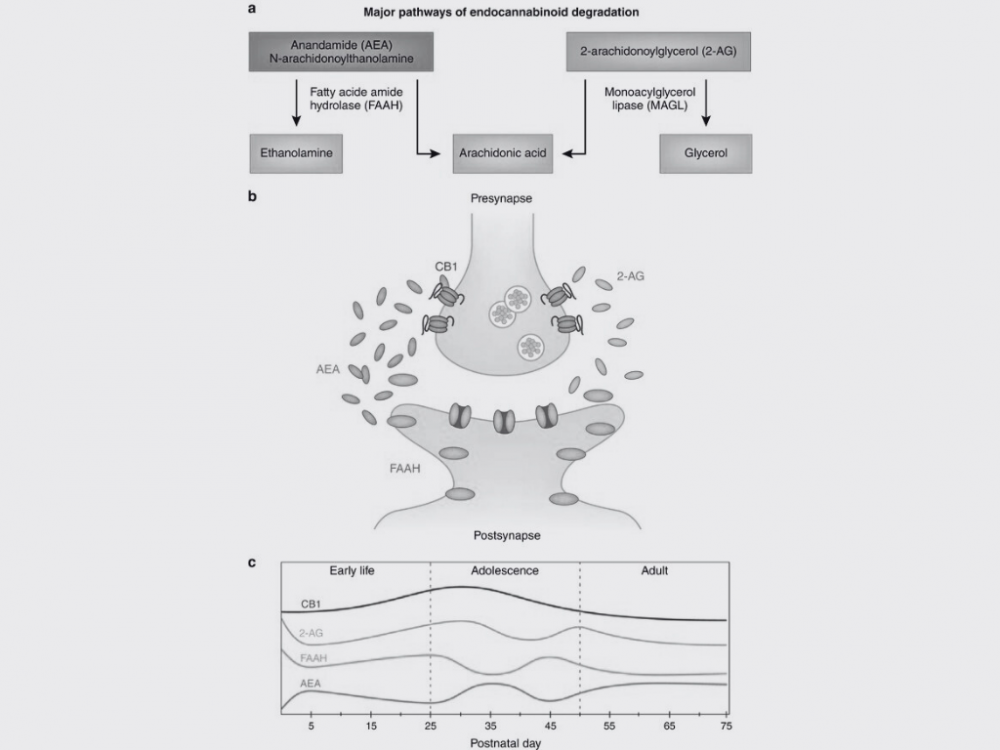
Deciphering the Intricacies of Endocannabinoid Degradation Pathways: Unveiling the Fate of Anandamide, 2-AG, Ethanolamine, Arachidonic Acid, and Glycerol
Endocannabinoids, such as anandamide and 2-arachidonoylglycerol (2-AG), are pivotal players in maintaining physiological balance within the human body. Understanding their degradation pathways is crucial, as these pathways help regulate the duration and magnitude of endocannabinoid signaling. Here, we delve into the major pathways of endocannabinoid degradation, highlighting the inputs, outputs, degradation components, and products, and explore their integration into normal physiology.
Anandamide Degradation Pathway: Balancing Bliss
Inputs: Anandamide, a primary endocannabinoid, is synthesized in response to various stimuli, including stress, pain, and inflammation.
Outputs: Anandamide is catabolized primarily by the enzyme fatty acid amide hydrolase (FAAH), yielding arachidonic acid and ethanolamine as products.
2-AG Degradation Pathway: Orchestrating Optimal Synaptic Function
Inputs: 2-AG, another key endocannabinoid, is synthesized in postsynaptic neurons in response to heightened neuronal activity.
Outputs: 2-AG undergoes degradation through the enzymes monoacylglycerol lipase (MAGL) and alpha-beta hydrolase domain-containing 6 (ABHD6), ultimately producing arachidonic acid and glycerol.
Ethanolamine Degradation Pathway: Ethanolamine’s Voyage
Inputs: Ethanolamine, a product of anandamide degradation, is further metabolized by acetyltransferases in cell membranes.
Outputs: This process generates acetylcholine, a neurotransmitter vital for various neural functions, including muscle control and memory.
Arachidonic Acid Pathway: A Multifaceted Molecule
Inputs: Arachidonic acid, a byproduct of both anandamide and 2-AG degradation, plays a versatile role in inflammation, immune response, and the production of eicosanoids.
Outputs: Eicosanoids, including prostaglandins and leukotrienes, are potent lipid signaling molecules that orchestrate inflammation and immune reactions.
Glycerol Pathway: Glycerol’s Utility
Inputs: Glycerol, originating from the degradation of 2-AG, is integrated into various metabolic processes in the body.
Outputs: Glycerol is crucial for glycerolipid biosynthesis, impacting energy storage and cell membrane structure.
These degradation pathways are not isolated events; rather, they are intricately woven into the tapestry of normal physiology. For instance, arachidonic acid, a product of endocannabinoid degradation, is a precursor for the synthesis of endogenous cannabinoids, such as anandamide. These processes occur throughout the body, but their activity can vary in response to diverse factors.
Factors Influencing Endocannabinoid Degradation
- Circadian Rhythms: Recent research has highlighted the influence of circadian rhythms on endocannabinoid signaling, with fluctuations in endocannabinoid levels occurring throughout the day[1].
- Stress and Inflammation: Stress and inflammatory conditions can trigger endocannabinoid synthesis and degradation, impacting the balance of endocannabinoid signaling[2].
- Environmental Factors: Diet, exercise, and exposure to environmental toxins can influence endocannabinoid degradation, affecting overall endocannabinoid tone[3].
- Genetic Variations: Genetic factors may modulate the expression and activity of enzymes involved in endocannabinoid degradation, leading to individual variability[4].
Understanding these intricate pathways and their integration into normal physiology sheds light on the dynamic regulation of endocannabinoid signaling, providing a foundation for exploring potential therapeutic interventions.
[1]: Dincheva, I., Drysdale, A. T., Hartley, C. A., Johnson, D. C., Jing, D., King, E. C., … & Cravatt, B. F. (2015). FAAH genetic variation enhances fronto-amygdala function in mouse and human. Nature Communications, 6, 6395.
[2]: Morena, M., Patel, S., Bains, J. S., & Hill, M. N. (2016). Neurobiological interactions between stress and the endocannabinoid system. Neuropsychopharmacology, 41(1), 80-102.
[3]: Di Marzo, V., & Silvestri, C. (2019). Lifestyle and metabolic syndrome: contribution of the endocannabinoidome. Nutrients, 11(8), 1956.
[4]: Dincheva, I., Drysdale, A. T., Hartley, C. A., Johnson, D. C., Jing, D., King, E. C., … & Cravatt, B. F. (2015). FAAH genetic variation enhances fronto-amygdala function in mouse and human. Nature Communications, 6, 6395.
📗 Note: This diagram is just a nibble. Take a bite out of the knowledge sandwich that is “The Doctor-Approved Cannabis Handbook” by clicking here 📗.

Summary Notes
Exploring the Major Pathways of Endocannabinoid Degradation
The degradation of endocannabinoids, such as anandamide (AEA) and 2-arachidonoylglycerol (2-AG), is a critical process within the endocannabinoid system (ECS), dictating the signaling strength and duration of these bioactive lipids. Understanding the major pathways and enzymes involved, like fatty acid amide hydrolase (FAAH) and monoacylglycerol lipase (MAGL), offers insights into the ECS’s role in maintaining bodily homeostasis and its implications for health and disease.
The enzymatic breakdown of endocannabinoids not only terminates their signaling actions but also influences the overall dynamics of the ECS. Inhibition of these degradation pathways has emerged as a therapeutic strategy to enhance endocannabinoid signaling, showing potential in treating conditions like anxiety, pain, and neurodegenerative diseases.
Research into the genetic and regulatory factors affecting endocannabinoid degradation offers the possibility of personalized medicine approaches, tailoring interventions to individual metabolic profiles. Moreover, understanding the interplay between endocannabinoid degradation and other metabolic pathways provides a holistic view of lipid signaling networks within the body.
The therapeutic implications of modulating endocannabinoid degradation are vast, with pharmacological inhibitors of FAAH and MAGL being studied for their potential to elevate endocannabinoid levels and ameliorate symptoms of various conditions. However, the bioactivity of endocannabinoid degradation products and the potential for off-target effects necessitate a cautious approach to developing such therapies.
As advances in enzyme research and degradation mechanisms continue to unfold, new avenues for enhancing ECS signaling and therapeutic interventions are emerging. Future research directions will likely focus on further elucidating these degradation pathways, developing specific inhibitors, and understanding the clinical implications of modulating endocannabinoid levels.
Educating healthcare professionals and patients on the importance of endocannabinoid degradation and its role in ECS signaling is crucial for the widespread acceptance and application of therapies targeting these pathways. As our knowledge expands, so too does the potential for innovative treatments that harness the power of the endocannabinoid system to improve health outcomes.

